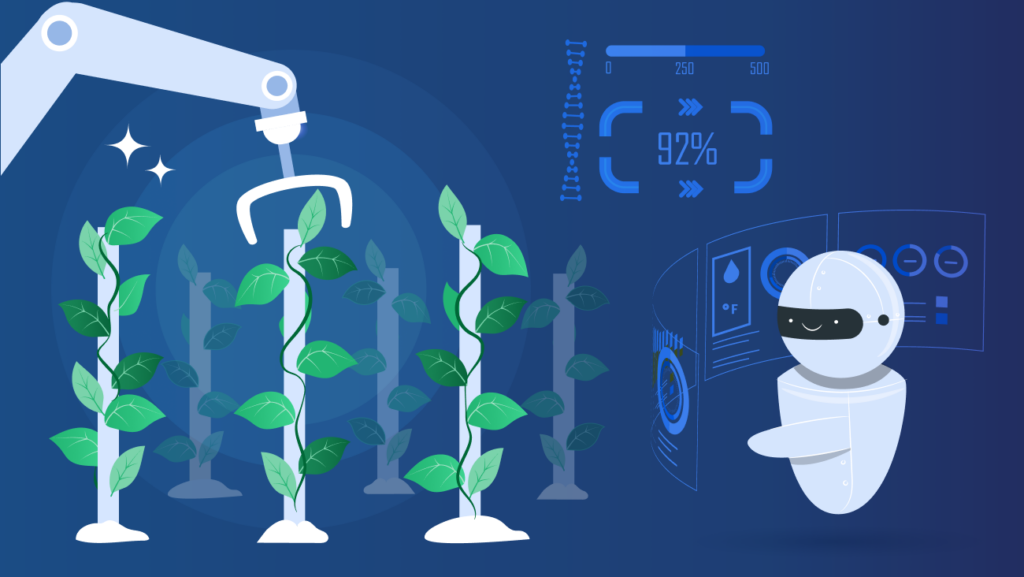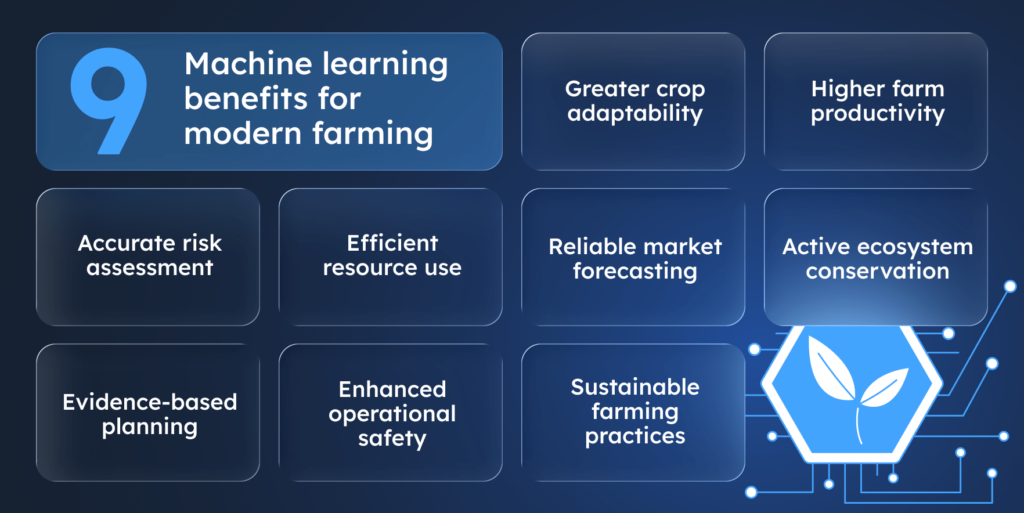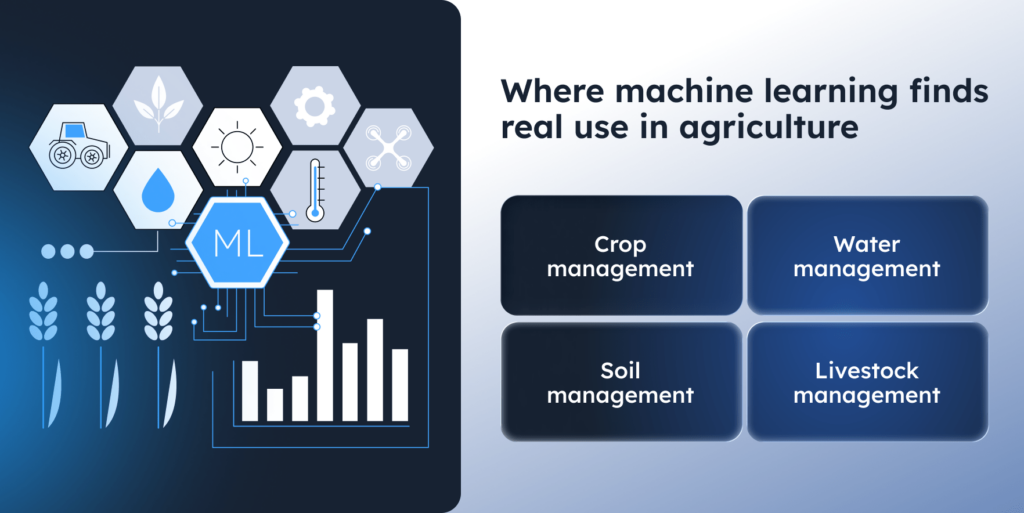Table of Contents
Machine learning in agriculture changes the way farmers grow crops, raise livestock, and gather harvest. By combining reliable data and technologies like IoT and data analytics, it helps farmers make better decisions, optimize resource allocation, and reduce crop loss risks.
In this article, we discuss the most compelling use cases of ML in agriculture and highlight its benefits, technologies, and potential to strengthen food security, adapt to climate change, and enhance sustainability efforts.

Why is machine learning so important in agriculture?
The world population is projected to reach 9.8 billion by 2050. In order to provide food security, the rural sector must achieve a 25–70% yield increase to cover growing demand. Yet, agriculture is exposed to multiple risks and uncertainties due to weather changes, pest and disease outbreaks, financial issues, and ever-changing market demands.
As a consequence, the industry suffers significant losses in production, waste of resources, and a decline in growth, failing to meet essential needs. This is where ML comes into play.
As with many other industries, machine learning is a major paradigm shift driver for the agricultural sector, implementing data-driven analytics, intelligent monitoring, and computer vision. The MarketsandMarkets report estimates that artificial intelligence (AI) in agriculture will reach $4.7 billion in 2028, from $1.7 billion in 2023. It highlights the demand for technology adoption and its perspectives to meet growing food needs.
As ML provides valuable insights and improves decision-making processes, it promotes precision agriculture (PA). This term refers to a crop management concept using high-tech sensors and analysis tools to enhance crop yields. The technology allows farmers access to more accurate data to more accurately predict demand, improve decision-making, increase crop yields, lower production costs, and automate agricultural operations.
It is only the tip of the iceberg. Let’s discover how this technology can help farmers tackle the major industry challenges.
Agriculture challenges machine learning can help with
The issues the agriculture industry faces today — climate change, soil erosion, and a lack of water — affect every region, from North America to Africa. However, ML can optimize farm management, equipping people with the solutions that help them adjust to challenges.
Soil degradation
Improper agricultural practices, such as overgrazing, excessive use of heavy machinery, monocropping, and excessive tillage, lead to soil compaction, salinization, and nutrient depletion, ultimately affecting soil productivity.
- The Philippines annually loses approximately 457 million tons of quality soil due to erosion.
- The US Midwest has lost 57.6 billion tons of soil over the last 160 years because of unsustainable agricultural practices.
- Data from the EU Soil Observatory indicates that 62% of European Union soils are unhealthy.
Machine learning in farming helps to implement soil health monitoring, analyze its properties, and develop plans for better agricultural land use. It’s not a one-size-fits-all solution: the advice is tailored to the climate, topography, and field characteristics.
Water scarcity
Agriculture consumes around 70% of fresh water resources. Its inefficient use contributes to water shortages, resulting in crop failures and livestock losses. ML can help farmers manage automated irrigation, find alternative water sources, adjust irrigation schedules, and implement water-saving practices such as using drip and sprinkler systems instead of flood irrigation.
Low yields
One of the key principles in agriculture is to plant the right seed in the right area at the right time. By analyzing complex data patterns and inputs from sensors, ML defines the optimal time to seed, harvest, and market, selecting the most suitable conditions in terms of illumination, temperature, humidity, and demand.
Pest and disease outbreaks
Sudden aphid infestation or rust outbreak can put the harvest at risk. Putting AI, ML, and visual computing on guard of your crop health in terms of early disease and pest detection can lower the risks of late interventions and plant decay.
SoftTeco has participated in the development of an AI-based software solution for banana leaf disease detection. The team has applied computer vision for object identification and advanced monitoring, deep learning for correct classification, and an AI module for image extraction. Together, they improved banana tree cultivation, automated agronomists’ routine tasks, and accelerated the detection of issues. The solution not only alerts about damaged leaves, but also creates reports of the plants’ condition and gives valuable care recommendations.
Weather conditions
Unfavourable or unpredictable weather can quickly diminish your yield and nullify all previous efforts. It remains one of the biggest farmers’ challenges, as it directly affects livestock productivity, crop growth, and overall income. ML makes weather prediction easier. The algorithms analyze historical weather data to forecast rainfalls, droughts, and heatwaves, allowing you to prepare in advance. For instance, GenCast, a probabilistic weather model, can generate global 15-day ensemble forecasts at 0.25° resolution.
Climate change
2024 has become the warmest year since 1850, when these records started. The trend contributes to the emerging climate anomalies, rising temperatures, and shifting rainfall patterns. Machine learning helps farmers to better navigate this changing environment. It elevates agricultural practices through defining optimal growing conditions, reducing carbon emissions by rational resource use, and building climate prediction and early warning systems for floods, storms, and frosts.
Benefits of machine learning in agriculture
Machine learning technology can increase yields and livestock productivity, reduce water and electricity costs, and support better farm management. Here is how.

Risk management
Farmers can use machine learning to predict which environmental or weather-related factors might harm their business, and take steps to mitigate negative impact and reduce wastage. For example, an ML-based rainfall forecasting system helps agronomists to sow crops, avoiding monsoon failures in India. It sends tailored SMS weather forecasts around a month in advance, allowing farmers to adapt to changing weather conditions, thus minimizing losses.
Data-driven decisions
ML models are capable of analyzing vast amounts of historical and real-time data to make informed decisions about plant or animal treatment and crop management. They provide site-specific recommendations based on soil moisture, nutrient levels, and crop health information, collected and analyzed in real-time. For example, the ML system indicates low phosphorus levels in the soil, indicating fertilization is needed for healthy plant development.
Resource management optimization
ML enables precise and efficient resource management by rapidly analyzing diverse data and optimizing agricultural operations, resulting in reduced spending on pesticides, fertilizers, water, and electricity. ML-based techniques for resource planning can increase yields by 20% and reduce water consumption by 15%.
Safety enhancement
ML systems allow farmers to ensure a healthier and safer working environment by automating many tasks, such as handling pesticides and heavy machinery. They also help to reduce equipment accidents, pesticide exposure, heat stress, and livestock injuries. For example, ML combined with video capturing detects abnormal livestock behavior like distress, aggression, or illness. Then, the system alerts personnel, enabling early treatment and reducing injury-related culling.
Crop resilience enhancement
By analyzing data on weather patterns, disease outbreaks, or insects, ML can provide early warnings and solutions that minimize crop losses. Moreover, it strengthens resilience through guiding adaptive farming practices, breeding climate-smart crops, and optimizing resource use. Let’s say the ML model predicts drought in two weeks. Then, it automatically adjusts irrigation schedules and nitrogen levels according to the zone and crop type.
Market and price prediction
Machine learning models can predict crop prices and market demand based on historical trends. They collect diverse data on weather, climate, supply, demand, and advise on crop diversification strategies, storage duration, and optimal selling times. Data shows that ML models can achieve 80% prediction accuracy, showing their capability to forecast crop prices and improve decision-making in agriculture.
Better sustainability
Economically viable, environmentally friendly, and socially responsible farming becomes more achievable with agricultural machine learning. Predictive models support biodiversity through precision land-use planning and reduce greenhouse gas emissions by optimizing pesticide and fertilizer applications.
Higher agricultural profitability
ML algorithms identify market trends so farmers can choose profitable crops for a season. They can analyze plant maturity and optimal harvesting time, and determine when and where to sell produce with maximum profit and minimum risk.
For example, the ML model forecasts a rise in soybean prices due to strong export demand. Guided by this data, farmers adjust their planting ratio in favour of soy beans, which leads to an estimated seasonal revenue increase.
Main Street Data and IBM Watson Decision Platform combined their efforts to enhance decision support in agriculture. Main Street Data enhances Watson data analytics with a Validator capability that benchmarks yield against output from similar fields, and its MarketVision functions that assist cultivators in optimizing the timing of crop sales for maximum profit.
Biodiversity protection
Machine learning in agriculture helps to preserve biodiversity within agricultural systems by detecting overfarming and deforestation that endanger plant and animal species. With the help of drone imagery, satellites, and computer vision, apps can identify changes in vegetation, land use, and conservation zones. This data allows farmers to adjust their agricultural practices and intervene early to prevent ecosystem damage.
For example, mapping the landscape using satellite imagery, spatial analysis, and ML helps to identify crop fields, water bodies, forests, and degraded zones and create continuous habitats and corridors for wildlife, pollinators, and beneficial insects.
The above benefits result in more productive, profitable, and sustainable farming operations. To provide businesses with these capabilities, ML relies on a variety of technologies.
The main machine learning technologies in agriculture
There are many technologies that make up machine learning. Below, we selected the most beneficial ones for agriculture.
Predictive analytics
Being a subset of data science, predictive analytics uses historical data to predict results and improve decision-making. In agriculture, it is used to forecast demand, irrigation requirements, crop yields, and weather patterns. Moreover, farmers can discover risks and opportunities in agriculture, such as early warning signs of crop diseases.
Computer vision
As an AI field, computer vision analyzes data from digital images and videos. Unlike humans, this technology can simultaneously process unlimited amounts of data captured by drones, sensors, or apps. Computer vision systems can analyze images, identify objects, measure them, monitor crop health and soil conditions, and sort and grade the harvest.
There is room for technology adoption in niches, too. For example, using visual computing and ML, SofTeco developed a mobile application for beekeeping, cutting hive inspection time by x6. The app allows beekeepers to automatically count the number of bees in a hive, track colony growth dynamics, and monitor their well-being.
Deep learning
This subset of ML is based on artificial neural networks, which allow its algorithms to learn from data similar to humans. Deep learning is a holistic technology; it extends beyond data patterns discovery, encompassing predictive analytics, speech recognition, natural language processing (NLP), anomaly detection, and more. It finds significant use in agriculture for operating voice-controlled farm assistants and directing tractors and harvesters in dynamic field landscapes.
Needless to say, that is not all. Machine learning covers deep neural networks (DNNs), NLP, automation, speech recognition, and many more technologies, making it a versatile tool for various applications. Let’s turn now to the most common machine learning use cases.
15 machine learning use cases in agriculture
Agriculture applications based on ML can be divided into four main groups: crop management, water management, soil management, and livestock management. Here is a closer look at each type.

Crop management
Crop management encompasses tracking plants from germination to harvesting. ML can support every step of this journey — take a look at prominent cases.
Weed detection
Weeds are a serious threat to agriculture because they quickly grow, spread disease, consume nutrients, and all these result in lower yields. With machine learning, farmers can early detect harmful plants, use herbicides only in affected areas, and modify weedkillers, making them more effective against persistent species. So, reducing chemical usage results in less environmental damage.
Machine learning in farming can also automate weeding. For example, an ML robot uses pattern recognition to target unwanted plants and, in turn, eliminate them.
Disease detection
The other threat to agriculture is crop diseases, which significantly reduce yield quality. At the same time, manual field inspection in search for signs of infection is time-consuming and may be inaccurate. ML helps implement precise crop monitoring and detect and manage diseases in farming.
Farmers can use computer vision, drones and image sensors to recognize images, analyze data, assess disease risks, recognize patterns, and implement early warning systems. Real-life example shows that combined use of spectrometers and ML can lead to 85% or higher accuracy in detecting tomato disease.
As a result of leveraging machine learning technologies, farmers can improve disease control strategies, reduce crop losses, and enhance overall agricultural productivity.
Yield prediction
Crop prediction is crucial to maximizing profits in the economy. However, such forecasting is challenging because it depends on evaluating multiple factors, such as crop parameters, environment, and their interaction. Nevertheless, ML and deep learning models demonstrate accuracy rates of 50–99%, predicting crop yields based on weather information, soil properties, and historical data.
Based on that information, agriculturists will be able to make informed decisions for better farm management during the harvest season. A good example of technology use is an ML-powered maze yield forecasting system developed for Sub-Saharan Africa, which provides skillful predictions and helps mitigate food shortages due to unfavourable climate conditions.
Seed quality evaluation
Conventional seed quality assessment relies on manual inspections and laboratory testing, both of which are lengthy and error-prone methods. In contrast, ML models achieve up to 80% accuracy in predicting germination capability. With the use of spectral analysis, image processing, and visual assessments, ML algorithms can assess seeds’ physical parameters accurately and quickly. The main evaluation characteristics include:
- Size
- Shape
- Viability
- Germination potential
This tech-based approach helps to make more accurate yield predictions, improve agricultural decision-making, and increase productivity. Quality seeds develop into plants that are healthy, homogeneous, and more pest- and disease-resistant.
Crop stress detection
Automated abiotic and biotic crop stress detection systems help to identify environmental factors and biological agents that influence a plant’s health, growth, and production. For example, sensors and cameras measure chlorophyll fluorescence and leaf growth dynamics, providing data that machine learning models analyze. Smart systems can evaluate stress tolerance for insects, environmental conditions such as drought, salinity, humidity, and diseases like barley’s powdery mildew and rot on wheat leaves.
The outcomes help farmers timely identify stressing factors and correct them by using pesticides, herbicides, fertilizers, regulating irrigation, or adding soil amendments.
Intelligent spraying
Precision spraying uses intelligent software to optimize and improve crop protection. The spraying systems utilize images and sensors to understand the characteristics of plants, soil, and other elements, thereby determining which chemicals to use. It provides a more precise way to apply pesticides and fertilizers based on crop type.
As a result, farmers are able to optimize spraying operations, reduce costs, and maximize crop yields.
Insect detection
Insects threaten crops, so their early detection prevents yield losses. Machine learning algorithms combined with visual computing can automatically detect insects, helping farmers identify infestations more accurately. Also, ML can analyze data from sensors placed in fields, which provide data on temperature, humidity, and other factors that may influence insect activity. A better understanding of insect behavior can help farmers target pest control efforts more effectively.
Modern neural networks like DeepPestNet and Tiny-LiteNet deliver impressive 98–99% accuracy in pest detection. Thus, by leveraging ML and IoT, farmers can maintain efficient agricultural processes, ensure crop health, maximize resources, and reduce the threat of insects.
Water management
Fresh water is a limited resource, and its wise consumption is vital for proper farming practices. Here is how agricultural machine learning contributes to more efficient and environmentally sustainable water management.
Irrigation planning
Irrigation plays a crucial role in agriculture. In addition to optimizing water usage and reducing water consumption, ML models can forecast weather conditions, gauge soil moisture, and adjust for soil temperature. Such analysis helps to adjust irrigation schedules accordingly, improving water efficiency automatically. The study suggests that using ML and IoT for thoughtful irrigation planning can reduce water demand by up to 25% compared to traditional irrigation.
Machine learning systems can predict the amount of water a particular crop will require at a specific time by analyzing weather data, soil moisture, crop type, and growth stage.
Weather monitoring
Weather monitoring is an essential aspect of agriculture, as weather conditions impact crop growth, irrigation needs, and overall farming operations. By providing more accurate predictions and actionable insights, machine learning can improve decisions, such as selecting the most suitable crop varieties, choosing harvesting time, or planning pasture.
For example, when the ML system detects warm temperatures and high humidity, it warns of potential fall armyworm or maize leaf blight outbreaks. Thus, farmers are able to cut down on the risk of crop damage due to disease outbreaks caused by weather.
Soil management
A comprehensive overview of your land, combined with wise soil management, helps farmers make informed decisions that improve crop yields while conserving resources. Here is how ML facilitates this process.
Soil health assessment
In smart farming, ML models analyze soil nutrient content, pH, organic matter, and texture to classify soil health. They can predict nutrient deficiencies, suggest amendments, and predict fertility. Machine learning promotes sustainable agriculture, helps to increase yields, and contributes to long-term soil health and productivity.
Based on soil health information, farmers can make well-informed decisions on crop selection, rotations, and targeted fertilization, maintaining balance and biological activity.
Soil contamination and degradation monitoring
Machine learning in farming assists farmers in detecting metals, pesticides, industrial chemicals, and other harmful substances. Technology facilitates early detection, risk assessment, and remediation measures, helping to maintain crop productivity, ensure food safety, and preserve ecosystem health.
ML algorithms use sensors, satellite data, spectral imaging, and historical soil records to predict contamination levels and detect early signs of degradation. They can do salinity mapping and allow the development of phytoremediation strategies to ensure sustainable agriculture.
Fertilizer recommendation
Machine learning enables precision fertilizer recommendation according to the data collected from soil sensors, like pH, texture, organic matter, macronutrients, and micronutrients levels. It reduces over-fertilization, minimizes expenses, and improves farm management with real-time data collection and analysis.
Livestock management
Livestock management can greatly benefit from machine learning apps. Farmers can use them to optimize livestock monitoring, health control, feed management, and breeding programs.
Animal disease detection
Agricultural machine learning is widely used in animal disease detection. With the help of computer vision and audition, ML-based systems can continuously assess animals’ health and behavior, enabling early identification and prevention of disease outbreaks. Such software analyzes large data sets, including images, animal voice signal recordings, videos of animal movements, and inputs from cameras and sensors to recognize complex patterns and spot the first infection signs with an accuracy of up to 96.7%.
Animal feeding habits monitoring
IoT and machine learning-based tools can monitor livestock feeding habits. They use data about chewing activity, foraging behaviors, and accelerations to identify animals with abnormal nutrition patterns, which may indicate a health problem. ML models can also help understand how different types of food affect animals, estimate intake, and predict changes in feeding behavior.
Pasture monitoring
Pasture management is another critical component of smart farming. Its reckless use causes overgrazing and, in the long run, soil erosion. Together with sensors, GPS technology, drones, and tractors, ML helps to identify and classify pasturelands, estimate biomass, and evaluate pasture quality. The insights can help farmers to make informed decisions on rotational grazing and enhance livestock productivity through optimal use of feed resources.
Final thoughts
Combined with IoT, robotics, computer vision, and big data, ML can make agriculture more predictable, productive, and environmentally responsible, no matter the climate or region. It is a future-proof step towards efficient, innovative, and precise farming. Machine learning in agriculture helps minimize the use of chemicals and fertilizers, manage weather, disease, and market risks effectively, as well as optimize operations from planting to harvesting.
The impact of ML might be greater than you think. At a global scale, it may help overcome challenges such as water scarcity, food shortages, and soil erosion, leading to a more thriving, sustainable, and secure future.
Yet, its implementation may require sufficient initial investments. The need for infrastructure upgrades, tool complexity, and connectivity issues hamper ML adoption. Governments acknowledge these difficulties and help to apply the technology by offering educational and training programs, grants, and regulatory support. A reliable tech partner is another key to success.
ML becomes a powerful tool only when properly implemented. If you need help, SoftTeco can assist you in adopting machine learning technology smoothly and efficiently. Contact us to learn more about ML solutions and how they might fit your project.


Comments